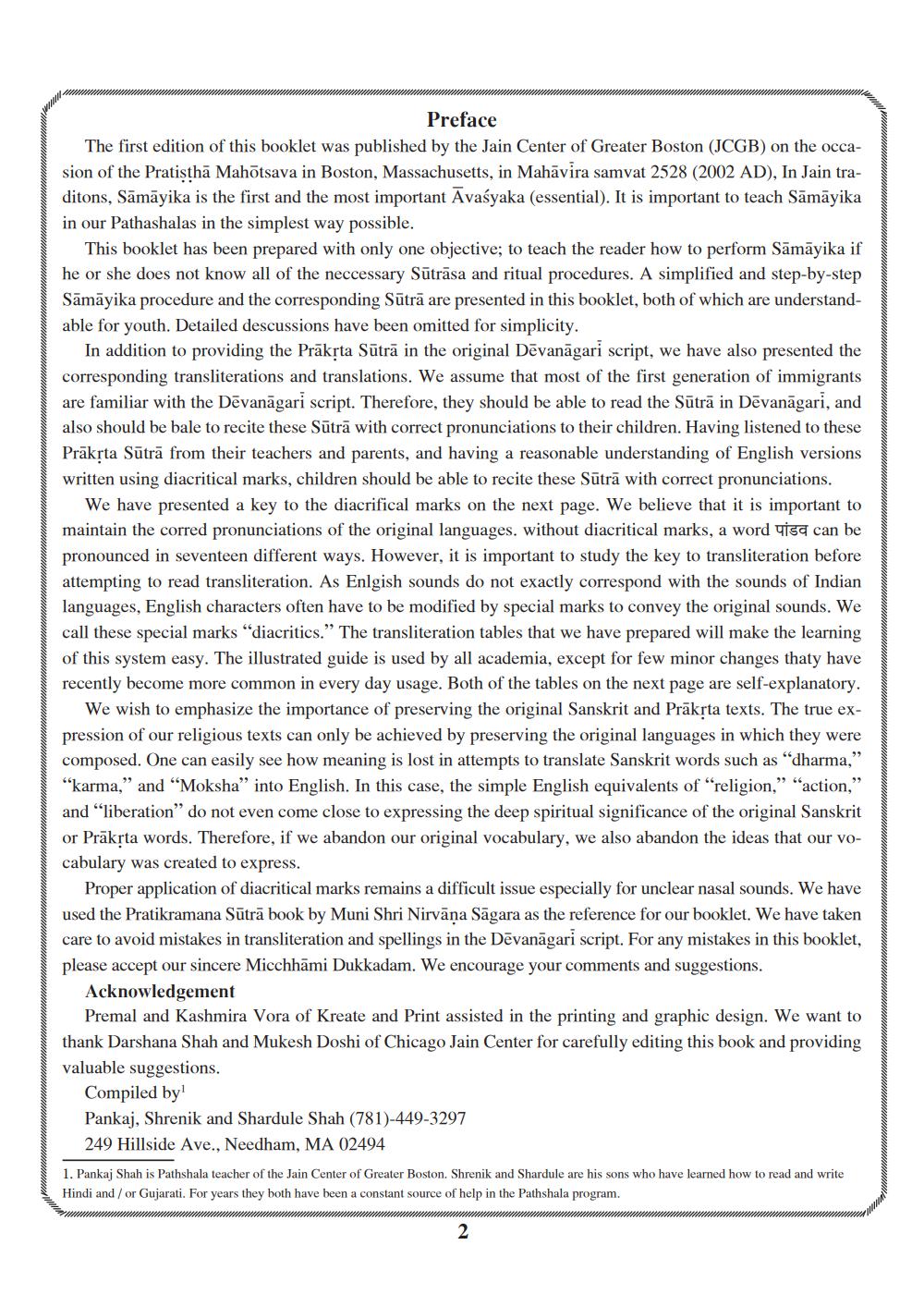Book Title: Samayik Sutra Author(s): Jain Center of Greater Boston Publisher: Jain Center of Greater Boston View full book textPage 5
________________ Preface The first edition of this booklet was published by the Jain Center of Greater Boston (JCGB) on the occasion of the Pratistha Mahotsava in Boston, Massachusetts, in Mahavira samvat 2528 (2002 AD), In Jain traditons, Sāmāyika is the first and the most important Avaśyaka (essential). It is important to teach Sāmāyika in our Pathashalas in the simplest way possible. This booklet has been prepared with only one objective; to teach the reader how to perform Sāmāyika if he or she does not know all of the neccessary Sūtrāsa and ritual procedures. A simplified and step-by-step Sāmāyika procedure and the corresponding Sūtrā are presented in this booklet, both of which are understandable for youth. Detailed descussions have been omitted for simplicity. In addition to providing the Prakrta Sūtrā in the original Dēvanāgari script, we have also presented the corresponding transliterations and translations. We assume that most of the first generation of immigrants are familiar with the Devanāgari script. Therefore, they should be able to read the Sūtrā in Devanāgari, and also should be bale to recite these Sūtrā with correct pronunciations to their children. Having listened to these Prākrta Sūtrā from their teachers and parents, and having a reasonable understanding of English versions written using diacritical marks, children should be able to recite these Sūtrā with correct pronunciations. We have presented a key to the diacrifical marks on the next page. We believe that it is important to maintain the corred pronunciations of the original languages, without diacritical marks, a word visa can be pronounced in seventeen different ways. However, it is important to study the key to transliteration before attempting to read transliteration. As Enlgish sounds do not exactly correspond with the sounds of Indian languages, English characters often have to be modified by special marks to convey the original sounds. We call these special marks "diacritics." The transliteration tables that we have prepared will make the learning of this system easy. The illustrated guide is used by all academia, except for few minor changes thaty have recently become more common in every day usage. Both of the tables on the next page are self-explanatory. We wish to emphasize the importance of preserving the original Sanskrit and Prākrta texts. The true expression of our religious texts can only be achieved by preserving the original languages in which they were composed. One can easily see how meaning is lost in attempts to translate Sanskrit words such as "dharma," "karma," and "Moksha" into English. In this case, the simple English equivalents of "religion," "action," and “liberation” do not even come close to expressing the deep spiritual significance of the original Sanskrit or Prāksta words. Therefore, if we abandon our original vocabulary, we also abandon the ideas that our vocabulary was created to express. Proper application of diacritical marks remains a difficult issue especially for unclear nasal sounds. We have used the Pratikramana Sūtrā book by Muni Shri Nirvāņa Sāgara as the reference for our booklet. We have taken care to avoid mistakes in transliteration and spellings in the Devanagari script. For any mistakes in this booklet, please accept our sincere Micchhami Dukkadam. We encourage your comments and suggestions. Acknowledgement Premal and Kashmira Vora of Kreate and Print assisted in the printing and graphic design. We want to thank Darshana Shah and Mukesh Doshi of Chicago Jain Center for carefully editing this book and providing valuable suggestions. Compiled by Pankaj, Shrenik and Shardule Shah (781)-449-3297 249 Hillside Ave., Needham, MA 02494 1. Pankaj Shah is Pathshala teacher of the Jain Center of Greater Boston. Shrenik and Shardule are his sons who have learned how to read and write Hindi and / or Gujarati. For years they both have been a constant source of help in the Pathshala program. W IMMWMMMMMMMMMMPage Navigation
1 ... 3 4 5 6 7 8 9 10 11 12 13 14 15 16 17 18 19 20 21 22 23 24 25 26 27 28
